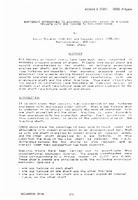| dc.contributor.author | Accardo, Lucio | |
| dc.contributor.author | Stori, Massimo | |
| dc.date.accessioned | 2018-10-11T14:05:19Z | |
| dc.date.available | 2018-10-11T14:05:19Z | |
| dc.date.issued | 1985/01 | |
| dc.identifier | 661 | |
| dc.identifier.govdoc | CP-36 | |
| dc.identifier.uri | http://hdl.handle.net/20.500.12489/99 | |
| dc.description.abstract | All navies, in recent years, have been much more concerned in economic cruising speeds of ships. Frigate type naval ships are usually characterized by two shafts, by multiple propulsion engines per shaft, and by different types of propulsion engines (gas turbines and diesels). When economic cruising speed is essential (for example during transit missions) naval ships are usually operated by asymmetrical shaft revolutions, with one propulsive shaft and the other trailing. This paper illustrates asymmetrical chart revolutions mode of operation compared to the even shaft revolutions mode of operation. | |
| dc.format | 8 p. : ill. , 30 fig. ; digital, PDF file | |
| dc.language | English | |
| dc.publisher | NATO. SACLANTCEN | |
| dc.source | In: Silent ship research applications and operation (SACLANTCEN Conference Proceedings CP-36), Vol. 2, 1985, pp. 1-1 - 1-8. | |
| dc.subject | Ships - design and construction | |
| dc.subject | Frigates | |
| dc.subject | Propulsion systems | |
| dc.subject | Propellers | |
| dc.title | Different approaches to economic cruising speeds on a CODOG frigate with due regard to radiated noise | |
| dc.type | Papers and Articles | |
| dc.type | Conference Proceedings (CP) | |
